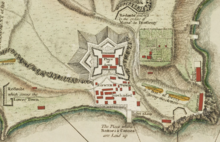Fort Carillon
Situated on the lake some 15 miles (24 km) south of Fort Saint-Frédéric, it was built to prevent an attack on Canada and slow the advance of the enemy long enough for reinforcements to arrive.
[1] Assigned to remedy Fort Saint Frédéric's inability to resist a constant British threat to the south, French King's Engineer Michel Chartier de Lotbinière began construction of Fort Carillon where Lake George, at that time called Lac Saint Sacrement, joins Lake Champlain by the La Chute river.
The portion remaining was strongly fortified by deep trenches, sustained by three batteries of cannon and, in front of the fort, blocked by trees which had been cut down and the pointed ends strengthened by fire, creating a formidable defensive system.
They were the Reine and Germaine bastions, with two demilunes (an outwork in front of a fort, shaped like a crescent moon) further extending the works on the land side.
[3][4] By fall, the fort was still not finished when an important discovery was made: as soon as the trees of the peninsula were cut, the French realized that the location they chose did not join well with the junction between the two lakes.
By January 1757, the fort was still incomplete and composed of earth and moats, mounted by 36 cannon waiting for an attack that the French were anticipating.
[6] On July 22, 1759, when orders were given to set fire to the town, the Indians could not believe that the French and Canadians would abandon what they had worked so hard to build.
The troupes de la terre were composed of professional soldiers of the French Army, sent from France to America, who were disciplined and well trained.
On August 9, 1757, Montcalm, with an army of 7,000 men consisting of French soldiers, Canadian militia, and Indians from various tribes, took Fort William Henry, situated at the southern point of Lake George.
The British had been humiliated and Montcalm had shown the compassion of a great general by stopping any further bloodshed by the Indians and accompanying the survivors.
[12] After a string of French victories in 1757, the British were prompted to organize a large-scale attack on the fort as part of a multifaceted campaign strategy against Canada.
[13] In June 1758, British General James Abercrombie began amassing a large force at Fort William Henry in preparation for the military campaign directed up the Champlain Valley.
[14] The French general Louis-Joseph de Montcalm, who had only arrived at Carillon in late June, engaged his troops in a flurry of work to improve the fort's outer defenses.
Brigadier General George Howe, Abercromby's second-in-command, had been killed when his column encountered a French reconnaissance troop.
[16] 1757 was therefore a bad year for the British in North America, not only because of their defeat in northern New York, but in the Ohio Valley and Nova Scotia as well.
The provincial regiments wore blue, but extensive modification of uniform was made to suit forest warfare with coats being cut back and any form of headgear and equipment permitted.
[11] While Montcalm and Vaudreuil were raising an army, American rangers proved to be too few to stop Indians from raiding the area around Fort William Henry at will.
In late June, a powerful Indian raiding party discovered that the road between the two forts was basically unguarded.
The French had a clear picture of the strategic situation in June, but six separate scouting parties were unable to penetrate the Indian screen to learn anything more detailed than that there was a large force at Fort Carillon.
While the fort was still under construction,[disputed – discuss], the French forces dug deep trenches flanked by three batteries of cannon.
The fort was also defended by a line of sharpened trees pointed towards the exterior and intertwined with branches and spikes installed during the night on orders from Montcalm.
[19] The British soldiers had to climb on each other's shoulders in order to reach the top of the trenches, so it was easy for the French to repulse them as they arrived near the summit of the defenses.
[20] Jeffery Amherst, now commander in chief of the British forces in America with 12,000 soldiers, prepared to move against Fort Carillon on July 21, 1759.
On July 22 and 23, Bourlamaque left the fort with 3,600 men and deployed 400 soldiers to set fire to the two hospitals, hangars, barracks, and to the lower part of the town.
After that, they moved up to Isle-aux-Noix where Amherst declined to advance against them, preferring to consolidate his forces in the lower Lake Champlain area.





